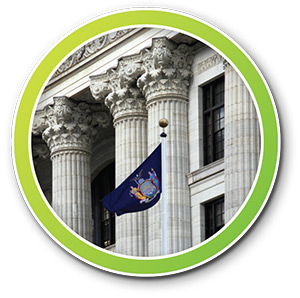 After decades of union activism, in late June of 2024 Gov. Kathy Hochul signed a package of APPR reforms into law that institute long-sought changes to the state’s teacher and principal evaluation system. The measure had strong support from NYSUT and a coalition of partners including the NYS Council of School Superintendents, the NYS School Boards Association, the NYS Parent Teacher Association and the State Education Department.
After decades of union activism, in late June of 2024 Gov. Kathy Hochul signed a package of APPR reforms into law that institute long-sought changes to the state’s teacher and principal evaluation system. The measure had strong support from NYSUT and a coalition of partners including the NYS Council of School Superintendents, the NYS School Boards Association, the NYS Parent Teacher Association and the State Education Department.
The new APPR system:
- Delinks teacher evaluations from student performance measures like test scores
- Requires that evaluation systems be bargained collectively and locally developed
- Requires that district evaluation plans be reviewed by SED and include multiple measures aligned with state teaching and leadership standards
- Institutes a four-level numbered rating system with four indicating exemplary performance, replacing the former HEDI scores of highly effective, effective, developing or ineffective
- Gives districts up to eight years to institute the new evaluation system
The changes eliminate the state’s former one-size-fits-all evaluation approach by allowing districts and BOCES to locally develop programs and giving unions and educators a seat at the table in evaluation design. Additionally, delinking student test scores puts an end to teaching to the test, helping to return a love of teaching and learning to the classroom.
NYSUT President Melinda Person joined SED Commissioner Betty Rosa in March to hand deliver copies of the bill to the offices of legislative Education Committee Chairs Sen. Shelley Mayer and Assemblymember Michael Benedetto to garner legislative support for the bill.
The current evaluation system was enacted in 2010 and substantially altered in the 2015-16 state budget. It instituted a system heavily reliant on student performance measures on grades 3-8 English language arts (ELA) and math assessments and a punitive, one-size-fits-all rubric to rate educators and principals. The requirement does not apply to teaching assistants, teacher aides or pupil personnel titles.
NYSUT went to court to challenge the State Education Commissioner’s regulations and advocated strongly for legislative changes following the 2015-16 evaluation changes. In Fall 2015, increased resistance to the poor implementation and improper use of state assessments associated with the Common Core Learning Standards led Gov. Cuomo to create a task force charged with making recommendations for the state’s standards, curriculum and assessments.
NYSUT successfully pushed hard for the task force to recommend decoupling the consequences of state assessments from APPR until a new system could be phased in.
In December 2015, the Board of Regents voted to implement a four-year moratorium on the consequences of using the state’s grades 3-8 ELA and math assessment in APPR, while SED worked to revise the standards and transition to a new vendor for the state assessments.
School districts and local bargaining units negotiated transitional APPR plans during that period using a matrix of teacher observation and other student performance measures to show student growth. Teacher growth measures, derived from the grade 3-8 ELA and math assessments, continue to be calculated but were provided for informational purposes only.
The 2019-20 State Budget made important changes to the student performance portion of the Annual Professional Performance Review, APPR (3012-c and 3012-d). The 2019 amendment to 3012-d eliminated the requirement to use state tests and gives the local collective bargaining representative the right to negotiate the selection and use of an assessment in a teacher or principal’s evaluation with the district. The system continued the two-category matrix system that includes student performance and teacher observations. The language eliminated the two-tier system where teachers in “tested” subjects must have individual SLOs or growth scores and teachers in “non-tested” subjects individual or group SLO’s. It also eliminated the calculation and use of the state provided growth model from APPR.
What Every NYSUT Member Should Know About...